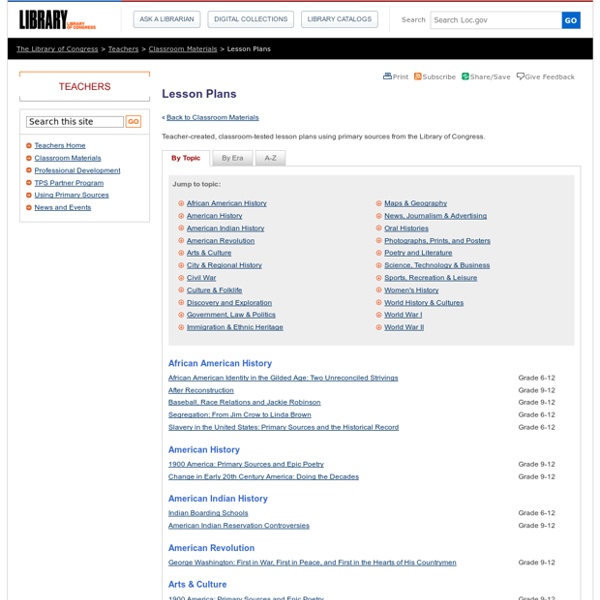Lesson Plans - Lesson Plan
Back to Classroom Materials Teacher-created, classroom-tested lesson plans using primary sources from the Library of Congress. African American History American History American Indian History American Revolution Arts & Culture City & Regional History Civil War Culture & Folklife Discovery and Exploration Government, Law & Politics Immigration & Ethnic Heritage Maps & Geography News, Journalism & Advertising Oral Histories Photographs, Prints, and Posters Poetry and Literature Science, Technology & Business Sports, Recreation & Leisure Women's History World History & Cultures World War I World War II Top Three Worlds Meet, Beginnings to 1620
Related: Curriculum
Understand what you read
Presentations and Activities
Presentations look across the American Memory collections to investigate curricular themes. They include historical background, helping to tell the story behind the theme. American Memory TimelineA comprehensive look at America's history, through primary sources... a teacher's wish, come true! TeachersStudents (Gr. 8- 12) The Branding of AmericaWhat are "brand name" products? ElectionsHow have elections changed over time? TeachersStudents (Gr. 5- 12) Fill up the CanvasWhat was the historical significance of the Lewis and Clark expedition? TeachersStudents (Gr. 4-12) From Fantasy to FlightUse these Resources from the Library of Congress documenting the history of flight the dreams, fantasies, experimentation and inventions that came before and after the historic achievement of the Wright brothers. TeachersStudents (Gr. 5-12) The Great American PotluckWhat can we learn about a nation from its food? TeachersStudents (Gr. 4- 12) TeachersStudents (Gr. 6-12) TeachersStudents of all ages
Teacher Resources
The Library of Congress offers classroom materials and professional development to help teachers effectively use primary sources from the Library's vast digital collections in their teaching. Find Library of Congress lesson plans and more that meet Common Core standards, state content standards, and the standards of national organizations. Discover and discuss ways to bring the power of Library of Congress primary sources into the classroom. Go to the blog Subscribe to the blog via e-mail or RSS. Using Primary Sources Discover quick and easy ways to begin using primary sources in your classroom, with teachers' guides, information on citing sources and copyright, and the Library's primary source analysis tool. TPS Partners The Teaching with Primary Sources Program builds partnerships with educational organizations to support effective instruction using primary sources. The Teaching with Primary Sources Journal
Lisa Nielsen: The Innovative Educator
My e-Products
We use cookies so we can provide you with the best online experience. You can change your cookie settings at any time. Otherwise, we'll assume you're OK to continue. <div style="text-align:center;padding:4px 0;color:#000000;font-family:Arial, Helvetica, sans-serif;font-size:10pt;"><a href="/AfcTool/popup?
Mapping History | DocsTeach: Activities: Create
Choose a set of documents to locate on a historic or outline map. Plot primary sources around the map and ask students to form geographic conclusions; ask students to analyze documents and position them on the map; or use the drawing tools to visualize geographic or manmade features. Learning Objectives and Historical Thinking Skills Mapping History activities teach students to use geographic information and information gleaned from primary sources to formulate historical conclusions. Mapping History activities teach students to use geographic information and information gleaned from primary sources to formulate historical conclusions. Mapping History activities can help students visualize geography and understand the themes of place and location. A teacher may choose a historical map or a blank outline map as the background for the activity. Students can practice forming historical conclusions about geographic regions through Mapping History.
Homepage - Teaching Matters
Gizmos: Math & Science Simulations Powering Inquiry and Understanding
Please provide as much of the following information as possible: Name of Gizmo Detailed description of issue Device being used Username Browser being used Location: Home, or school Please provide as much of the following information as possible: Name of Gizmo Title of Lesson Material Detailed description of issue Please provide your username and as much information as possible with your request. Have you tried Login Help? If you are a student, consider asking your teacher, or providing us the following information: your full name and your teacher's name. If you are a teacher, please provide us with the 8-digit Registration Key provided by your Gizmos administrator. If you are a student, please provide us with the 10-digit Class Code provided by your teacher. Please provide your username along with your request. Please provide as much information as possible in your request. Please provide as much of the following information as possible: Your School Your District Time and date of webinar
eClips™
NASA eClips™ are short, relevant educational video segments. These videos inspire and engage students, helping them see real world connections. Full Site Located: Grades K‑5 The Our World program supplements existing elementary learning objectives not only in science, technology, engineering and mathematics, but also in reading, writing, and visual and performing arts. Grades 6‑8 Real World video segments connect classroom mathematics to 21st century careers and innovations and are designed for students to develop an appreciation for mathematics through real-world problem-solving. Grades 9‑12 Launchpad video segments support project-based and problem-based learning experiences in science, mathematics, and career and technical education classrooms. General Public The NASA 360 thirty-minute magazine style program highlights NASA's impact on daily lives, showcasing some of the 30,000 inventions developed by NASA over the past 50 years.
Related:



